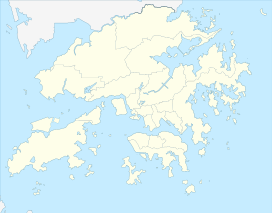Tai Mo Shan
| Tai Mo Shan | |
|---|---|

Tai Mo Shan, viewed from Tai To Yan
|
|
| Highest point | |
| Elevation | 957 m (3,140 ft) |
| Coordinates | 22°24′42.52″N 114°7′23.32″E / 22.4118111°N 114.1231444°ECoordinates: 22°24′42.52″N 114°7′23.32″E / 22.4118111°N 114.1231444°E |
| Geography | |
| Location | Centre of the New Territories, Hong Kong |
| Tai Mo Shan | |||||||||||||||
| Traditional Chinese | 大帽山 | ||||||||||||||
|---|---|---|---|---|---|---|---|---|---|---|---|---|---|---|---|
| Literal meaning | Big Hat Mountain | ||||||||||||||
|
|||||||||||||||
| Transcriptions | |
|---|---|
| Standard Mandarin | |
| Hanyu Pinyin | Dàmàoshān / Dàmào Shān |
| Hakka | |
| Romanization | Tai4 Mau4 San1 |
| Yue: Cantonese | |
| Yale Romanization | daaih mouh sāān |
Tai Mo Shan (Chinese: 大帽山) is the highest peak in Hong Kong, with an elevation of 957 m. It is also the tallest coastal peak in Southern China and second tallest coastal peak in China after Mount Lao, and located at approximately the geographical centre of the New Territories.
The Tai Mo Shan Country Park covers an area of 14.40 km² around Tai Mo Shan. It is located to the north of Tai Lam Country Park. It is noted to have the 35-metre high Long Falls, the highest waterfall in Hong Kong.
The whole Tai Mo Shan mountain range, known as Guang Fu Mountain (官富山, named after the salt field Kwun Fu Cheung (官富場) in present-day Kowloon Bay) in Ming and Qing dynasties, covers over 350 square km, and stretches from Tai Lam Chung Reservoir in the West near Tuen Mun and Ma On Shan in the east and the mountains of Kowloon and Clear Water Bay in the south. Two other significant coastal peaks, the Lantau Peak (934m) on Lantau Island and Mount Wutong in Shenzhen (943.7m) are approximately 27 km to the southwest and 21.5 km to the northeast respectively.
As a former volcano, that has long been extinct, Tai Mo Shan is composed of volcanic rocks from the Jurassic age. Today a small hill that is part of Tai Mo Shan, known as "Kwun Yum Shan", still vents warm air though cracks in the rocks that lead all the way to the mantle. The holes that exhale warm air are known as "hot pots". When the surface temperature is cold, and the warmth of the expelled air is clearly discernible, this phenomenon is referred to by locals as "dragon's breath". If the air temperature at the summit is 6 degrees Celsius, then the air emerging from the interior of Kwun Yum Shan is somewhere between 13 and 21 degrees Celsius. These "hot pots" are now just mild remnants of the intense superheated steam vents of the volcanic past. The volcanic rocks are mainly coarse ash crystal tuff.
...
Wikipedia

